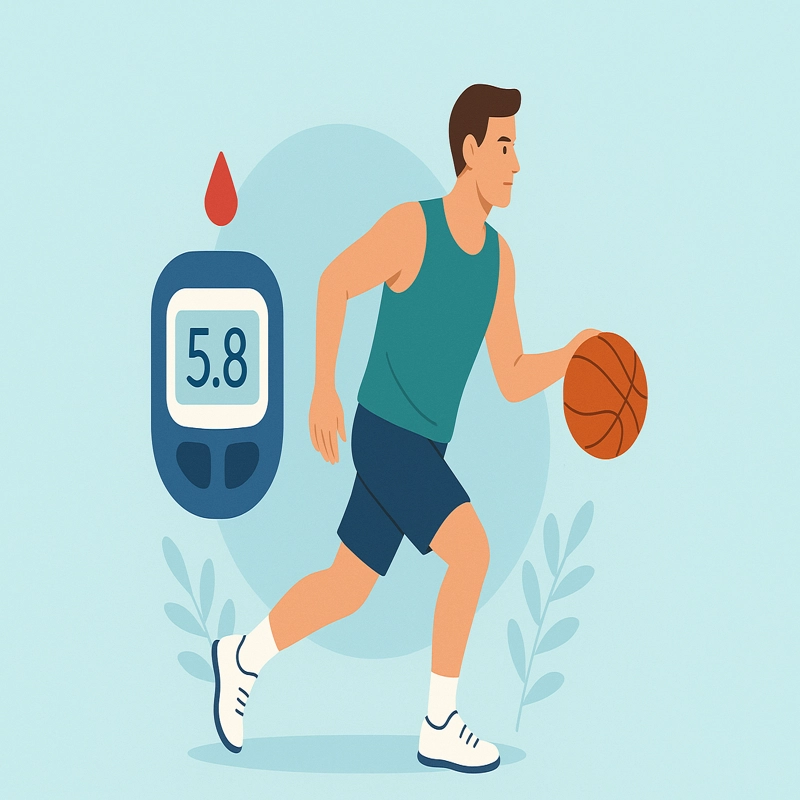Home/Wellness Zone/Sakra Blogs
14th Nov, 2025

Managing diabetes while staying active in sports may seem challenging, but with the right approach, athletes can perform at their best while keeping their blood sugar under control. Whether you’re a professional athlete or a fitness enthusiast, learning how to lower glucose levels safely and effectively is key to maintaining both energy and health.
Exercise is one of the most powerful tools to lower blood sugar levels naturally. During physical activity, your muscles use glucose for energy, which helps reduce excess sugar in the bloodstream. Over time, regular workouts improve insulin sensitivity, allowing your body to use glucose more efficiently.
However, athletes with diabetes need to carefully balance exercise, nutrition, and medication to avoid sudden spikes or drops in blood sugar.
Staying active is one of the best ways to control diabetes, but athletes need to manage blood sugar carefully around workouts. Here’s how to prepare your body and keep glucose levels stable before, during, and after exercise.
Monitor Your Blood Sugar: Always check your blood sugar before and after workouts. Knowing your numbers helps you decide if you need a snack before starting or if you should adjust your insulin dosage.
Eat Balanced Meals: Include complex carbohydrates, lean proteins, and healthy fats in your diet. Avoid refined sugars that cause rapid spikes in glucose.
Stay Hydrated: Dehydration can raise blood sugar levels. Drink plenty of water before, during, and after sports activities.
Time Your Meals and Workouts: Exercising too soon after eating can lead to low blood sugar. Plan your meals and workouts to keep energy levels stable.
Carry Quick Carbs: Always have a quick source of sugar like glucose tablets or fruit juice handy. These can help lower your blood sugar safely if it drops too much during exercise.
Yes, exercise can lower blood sugar effectively and quickly. Even short bursts of activity, like brisk walking or cycling, help muscles absorb more glucose from the bloodstream. For athletes, combining aerobic and resistance training works best to lower glucose levels and enhance overall fitness.
However, overexertion can sometimes lead to hypoglycemia (low blood sugar). That’s why consistent monitoring is vital before, during, and after workouts.
If your blood sugar spikes due to stress, poor diet, or missed medication, here’s how to lower blood sugar quickly and safely:
Engage in light exercise such as a 15–20-minute walk.
Drink water to flush out excess glucose through urine.
Choose foods rich in fiber and protein to balance levels.
Avoid sugary drinks or high-carb snacks that can worsen spikes.
Managing diabetes while training or competing takes awareness and consistency. The right habits can help you stay on top of your game while keeping your blood sugar in check. Here are some smart strategies to follow:
Work closely with your doctor or sports nutritionist. They can tailor your medication, meal plan, and exercise schedule.
Track patterns. Record your glucose readings, workouts, and meals to identify what works best for your body.
Use technology. Continuous glucose monitors (CGMs) and smart insulin pumps can help you stay in control without interrupting your performance.
Rest and recover. Overtraining can increase stress hormones, which raise blood sugar levels. Get enough rest and recovery time.
Diabetes doesn’t have to limit your athletic goals. By understanding how to lower glucose levels, maintaining a balanced routine, and listening to your body, you can achieve top performance while keeping your blood sugar in check. With discipline, smart nutrition, and consistent monitoring, athletes with diabetes can excel in any sport.
1. Can athletes with diabetes play sports?
Absolutely. With the right care, meal planning, and regular monitoring, people with diabetes can perform just as well as anyone else.
2. Can exercise lower blood sugar?
Yes, it can. When you’re active, your muscles use up more glucose, which helps bring your blood sugar down naturally.
3. How can I lower my blood sugar quickly after a workout?
Drink some water, have a light snack with protein and fiber, and keep an eye on your glucose levels.
4. What exercises help lower glucose levels the most?
Walking, jogging, cycling, swimming, and strength training all help lower glucose levels effectively.
5. How often should I check my blood sugar during exercise?
It’s best to check before and after your workout. If you’re exercising for a long time, check midway too
Director - Department of Endocrinology, Diabetes, Obesity & Weight Management
Book an AppointmentEnquire Now
